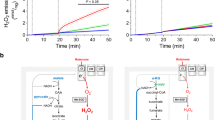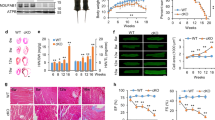Abstract
Mitochondria are the main source for ATP, but also reactive oxygen species (ROS). While NADH is required for ATP production, NADPH regenerates anti-oxidative capacity to prevent excessive ROS emission. The mitochondrial transhydrogenase links NADH with NADPH pools and is mutated in C57BL/6 mice from Jackson Laboratories. While in most scenarios, the transhydrogenase regenerates NADPH in the forward mode, it can reverse under pathological conditions and cause oxidative stress and heart failure.
Similar content being viewed by others
Literatur
Nickel A, Löffler J, Maack C (2013) Myocardial energetics in heart failure. Basic Res Cardiol 108:358
Rydstrom J (2006) Mitochondrial NADPH, transhydrogenase and disease. Biochim Biophys Acta 1757:721–726
Kohlhaas M, Liu T, Knopp A et al. (2010) Elevated cytosolic Na+ increases mitochondrial formation of reactive oxygen species in failing cardiac myocytes. Circulation 121:1606–1613
Toye AA, Lippiat JD, Proks P et al. (2005) A genetic and physiological study of impaired glucose homeostasis control in C57BL/6J mice. Diabetologia 48:675–686
Mekada K, Abe K, Murakami A et al. (2009) Genetic differences among C57BL/6 substrains. Exp Anim 58:141–149
Freeman H, Shimomura K, Horner E et al. (2006) Nicotinamide nucleotide transhydrogenase: a key role in insulin secretion. Cell Metab 3:35–45
Huang TT, Naeemuddin M, Elchuri S et al. (2006) Genetic modifiers of the phenotype of mice deficient in mitochondrial superoxide dismutase. Hum Mol Genet 15:1187–1194
Kim A, Chen CH, Ursell P et al. (2010) Genetic modifier of mitochondrial superoxide dismutase-deficient mice delays heart failure and prolongs survival. Mamm Genome 21:534–542
Meimaridou E, Kowalczyk J, Guasti L et al. (2012) Mutations in NNT encoding nicotinamide nucleotide transhydrogenase cause familial glucocorticoid deficiency. Nat Genet 44:740–742
Nickel AG, von Hardenberg A, Hohl M et al. (2015) Reversal of mitochondrial transhydrogenase causes oxidative stress in heart failure. Cell Metab 22:472–484
Szeto HH (2014) First-in-class cardiolipin-protective compound as a therapeutic agent to restore mitochondrial bio-energetics. Brit J Pharmacol 171:2029–2950
Author information
Authors and Affiliations
Corresponding author
Additional information
Albrecht von Hardenberg 2006–2013 Medizinstudium an den Universitäten Homburg und Oviedo, Spanien. 2009–2016 Promotion in der Arbeitsgruppe von C. Maack. Seit 2013 Assistenzarzt in der Klinik für Innere Medizin III, Universitätsklinikum des Saarlandes, Homburg.
Christoph Maack 1993–2000 Medizinstudium an der Universität zu Köln. 2000–2002 und 2005–2012 Assistenzarzt an der Klinik für Innere Medizin III, Universitätsklinikum des Saarlandes, Homburg, seit 2012 dort Oberarzt. 2002–2005 Postd°C an der Johns Hopkins University in Baltimore, MD, USA in der Arbeitsgruppe von Prof. Dr. B. O’Rourke. 2006–2011 Emmy Noether-Programm, seit 2012 Heisenberg-Professur für Kardiovaskuläre Physiologie und Bioenergetik.
Alexander Nickel 1998–2004 Ökotrophologiestudium an der TU München. 2004–2009 Promotion im Bereich Nierenphysiologie. Seit 2009 wissenschaftlicher Mitarbeiter in der Arbeitsgruppe von C. Maack, Klinik für Innere Medizin III, Universitätsklinikum des Saarlandes, Homburg.
Rights and permissions
About this article
Cite this article
Von Hardenberg, A., Nickel, A. & Maack, C. Mitochondriale Transhydrogenase: Yin und Yang der antioxidativen Kapazität. Biospektrum 23, 22–24 (2017). https://doi.org/10.1007/s12268-017-0760-1
Published:
Issue Date:
DOI: https://doi.org/10.1007/s12268-017-0760-1




